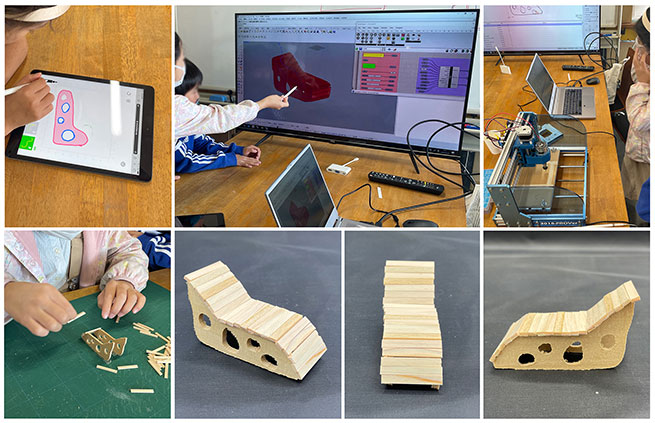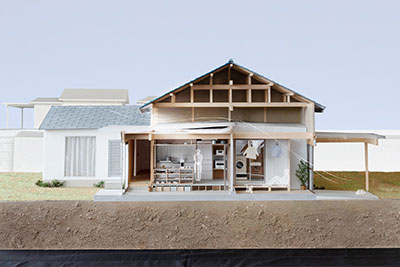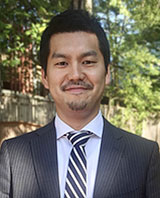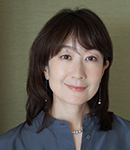
ここからコンテンツです。

Communication via computers, and their application to architectural design
Akihiro Mizutani

The use of computers in architectural design and urban development, starting with 3D-Computer-aided Design (CAD) and Building Information Modeling (BIM), is already common, and dates back to the Sixties, right at the dawn of the computer era. Associate Prof. Mizutani has been looking into the potential of computers as thinking tools by delving into the history of computer use in architectural design, and reassessing its significance. In addition to theoretical research, he is also working on implementation design, pursuing the optimal ways to combine our strengths with those of computers, or existing systems and computers, while working on implementation design.
Interview and report by Madoka Tainaka
Current Significance of Computer Application at the Tange Laboratory
Kenzo Tange is renowned as the architect who designed the Yoyogi National Stadium and Hiroshima Peace Memorial Park. Although considered a great master who laid the foundations for modern Japanese architecture and nurtured many protégées, including Arata Isozaki and Kisho Kurokawa, it is not widely appreciated that the Kenzo Tange Laboratory at the University of Tokyo was an early adopter of computers from around 1960. Associate Prof. Mizutani studied under Hajime Yatsuka, an architectural student of Kenzo Tange, while a graduate student at the Shibaura Institute of Technology. He was engaged in preparations for the "Metabolism Exhibition"* planned by Mr. Yatsuka (hosted by Mori Art Museum from September 2011 to January 2012), and researched the history behind the Tange Laboratory’s use of computers, which sparked an abiding interest in the subject.

Associate Prof. Mizutani explained, "In those days, there was already a trend towards applying computers to architectural construction and planning, but in terms of urban planning, the Kenzo Tange Laboratory at the University of Tokyo led the way. Professors Manabu Yamada and Yoshio Tsukio were primarily responsible for this, and their "Survey into the flow of employees and visitors through the Tokyo Metropolitan Government Building" in 1963 was reputedly a first. This gave rise to the development of a computer language specifically for urban design, known as URTRAN, and the means to simulate crowd flows for the 1970 Osaka Expo, etc."
An interesting side-note is that the Tange Laboratory’s interest in computers was triggered by a thesis entitled "The Use of Diagrams in Highway Route Location" by C. Alexander and M.L. Manheim. The paper patterned each of the 26 determinants of highway construction (cost of land work, comfort and safety, development potential of the area...), and by painting the best areas black, the area with the darkest colour when these patterns were superimposed was shown as the best route.
"This method is interesting because by prioritizing the determining factors and adjusting the overlapping layers, we can freely select or discard different factors. Although Alexander et al. did not use computers, the Tange Laboratory had the foresight to consider that computers could be applied here to simulate macro urban design."
These efforts of the Tange Laboratory were held up by various factors. To begin with, student protests that rocked academia in the late Sixties, rendering the campus’s mainframe computer unusable for two years. There were also some teething troubles for the early computers. Finally – triggered by Expo ’70 – Arata Isozaki started considering architecture separately from cities related to governmental power (the so-called, "Withdrawal from the City" declaration), leading architects who sympathized with him to lose interest in cities.
"Having said that, this initiative by the Tange Laboratory was groundbreaking in terms of using computers, not only for efficiency, but also to clarify the designers’ thought and design processes, and bolster the logic of the actual plans. This still holds true today, thanks to the massive development of modern computers, and has become a primary motivation for me to theorize about the role of computers in architectural design."
*Metabolism Exhibition
This exhibition reviewed an architectural movement that sprang up around 1960 led by young architects, such as Kisho Kurokawa, Kiyonori Kikutake, and Fumihiko Maki. As per its name – Metabolism – it reflects changes in society and demographics, and proposed an image of cities and architecture that grow organically.
Exploring the Potential of Digital Technology
While developing design tools, Associate Prof. Mizutani promotes research into how computers actually affect design in tandem with theorizing about computational design in architecture. One such initiative is a workshop on the digital fabrication of chairs (using software to support manufacturing).
He said, "In this workshop, we developed a support tool that presents a 3D image of a chair on the display simply by inputting three lines and specifying each component’s dimensions, etc. We also developed a tool that enables input on a tablet just like drawing a picture with a pen and paper. These have enabled anyone – even elementary school students – to design original chairs of their own simply by applying designs for the sides of the chair, with the flexibility to adjust the pitch of the seat panel."

In addition, Associate Prof. Mizutani proactively uses visual programming and other design tools to conduct structural analyses, such as gravity-induced deflection, while studying the model on the screen. Head-mounted VR displays also help them to draft design proposals and form a consensus.
He added, "When drawing a design on paper, you need to redraw the whole thing whenever you want to make a small change to the shape, don’t you? However, digital technology enables you to simply amend the draft design by changing some parameters, or visualise and communicate our images to each other during collaborative work. In other words, the time needed for drawing and communication can be significantly reduced. As a result, we can concentrate purely on the creative elements, such as design. I believe that such "appropriate" use of computers like this leads to better design."
Creating Better Architecture is the Goal
On the other hand, Associate Prof. Mizutani does not consider computers as indispensable to modern architectural design. He reiterated, "Models are still relevant in architectural design, and I also sometimes design without resorting to a computer. Our objective is simply to create good architecture, and computers are purely a means to that end. Actually, regarding the work selected for the SD Review sponsored by Kajima Institute Publishing Co., Ltd. in 2022, although we used computers for some environmental simulations, etc., most of the basic design derived from hand-built models. While it depends on the architectural scale, I often come up with better ideas by starting out with a hand-drawn sketch. For that reason, I think it is important to use computers appropriately by playing to their strengths."

On the other hand, he also feels that we have some way to go before we can claim to be fully utilizing the strengths afforded by computers and applying our knowledge of informatics to modern architectural design. Prof. Mizutani concluded by saying, "Whether or not we use a computer will affect how a design is expressed. However, it is too soon to say that digital technology is capable of creating unique advanced architecture. Why is this? Is it due to limitations of the tools, or just how they are used? I personally believe that computers will be used to create even better architectural designs in the future, so I want to continue exploring how best to use computers to produce better architecture."
Reporter's Note
Associate Prof. Mizutani first became interested in architecture while at junior high school – in part because his father was engaged in an architectural job. A visit to the Kisho Kurokawa Retrospective when he was at senior high school set the course for his future.
Associate Prof. Mizutani said, "I was incredibly impressed at the time by the model of the Project for a Helix City for Tokyo (1961) inspired by the double-helix structure of DNA. Later, in what seemed like fate to me, I re-encountered this model at the Metabolism Exhibition." After graduating from university, he joined Kengo Kuma & Associates as he had decided to work as an architect, but unable to give up his passion for research, he returned to university to pursue his doctorate. Subsequently, he opted for an interdisciplinary approach as a "professor architect" which allowed him to engage in both research and practical work. I am confident that he will continue to pioneer new architectural approaches in this digital era through both theoretical research and practice.
コンピュータと対話し、建築デザインに役立てる
現在でこそ、3D-CAD(Computer aided Design)やBIM(Building Information Modeling)をはじめ、建築設計や都市開発においてコンピュータは当たり前に活用されているが、その歴史はコンピュータの黎明期の1960年代まで遡る。水谷晃啓准教授は、建築設計におけるコンピュータ利用の歴史を繙き、その意味を読み直すことで、思考の道具としてのコンピュータの可能性を探っている。さらに、理論研究だけでなく、実施設計にも取り組みながら、人とコンピュータ、もしくは既存のシステムとコンピュータの最適な組み合わせを追究している。
丹下研究室のコンピュータ利用の今日的意義
国立代々木競技場第一体育館や広島平和記念公園などの建築で知られる丹下健三氏。日本の近代建築の礎を築き、磯崎新氏や黒川紀章氏をはじめ多くの後進を育てた大家だが、実は東京大学の丹下健三研究室で1960年頃の黎明期から、いち早くコンピュータを取り入れていたことはあまり知られていない。水谷准教授は、芝浦工業大学大学院に在籍中、丹下健三の系譜を引く建築家の八束はじめ氏に師事。八束氏が企画した「メタボリズム展※」(2011年9月〜1月、森美術館にて開催)の準備に携わり、丹下研のコンピュータ利用の歴史を調べて、大きな興味を抱いたという。
「当時すでに、建築構造や建築計画についてコンピュータを取り入れる動きはありましたが、都市計画では東京大学の丹下健三研究室がリードしていました。これを担ったのが、山田学先生と月尾嘉男先生で、1963年に『東京都庁舎の庁内の職員、来客に関する流動調査』を行なったのが最初とされています。この取り組みは、URTRANというアーバン・デザイン専用のコンピュータ言語の開発や、1970年の大阪万博における群衆流のシミュレーションなどへと発展していきました」と水谷准教授は説明する。
興味深いのは、丹下研がコンピュータ利用に着目したきっかけが、C.アレクザンダーとM.L.マンハイムの"The Use of Diagrams in Highway Route Location”という論文に端を発することだ。この論文は、高速道路建設における26個の決定要因(土地作業のコスト、快適さと安全性、当該地域の発展性…など)をそれぞれパターン化し、最適な領域を黒く塗りつぶすことで、それらのパターンを重ね合わせた際に最も色が濃くなるエリアを最適なルートとして示す、というものだった。
「この手法が面白いのは、決定要因に優先順位をつけたり、重ね合わせる階層を変えたりすることで、人間が要素の取捨選択を自在にできる点にあります。実はアレクザンダーらはコンピュータを使っていないのですが、この方法にコンピュータを使い、マクロなアーバン・デザインのシミュレーションに応用できると考えたところに丹下研の慧眼がありました」
なお、こうした丹下研の試みは、1960年代末の大学紛争で学内のメインフレームが2年間ほど使えなくなったことや、1970年の万博を機に、磯崎新氏が国家権力と結びついた都市から建築を切り離して考えるようになり(いわゆる「都市からの撤退」宣言)、これに共鳴した建築家らが都市への関心を失ったこと、さらにはコンピュータの発展途上におけるさまざまな障壁で下火になっていった。
「とはいえ、この丹下研の取り組みは、コンピュータを単なる効率化のためではなく、デザイナーの思考やデザインのプロセスを明確化し、計画自体の論理性を高めるために用いた点で画期的でした。そしてそれは、コンピュータが飛躍的に発達した今日でも有効であり、私自身、建築デザインにおけるコンピュータの役割を理論化するうえでの大きなモチベーションになっているのです」
※メタボリズム展
1960年頃に、黒川紀章や菊竹清訓、槇文彦ら若手建築家らが開始した建築運動を総括した展覧会。新陳代謝(メタボリズム)の名の通り、社会の変化や人口動態を反映し、有機的に成長する都市や建築の姿を提案した。
デジタルテクノロジーの可能性を探る
水谷准教授は建築におけるコンピュテーショナル・デザインの理論化と並行して、コンピュータが実際にデザインにどのような影響をもたらすのか、デザインツールを開発しながら研究を進めている。その一つの取り組みが、デジタルファブリケーション(ものづくり支援ソフト)を使った椅子づくりのワークショップだ。
「このワークショップでは、3本の線の入力と部材の寸法などを設定するだけで、ディスプレイ上に三次元の椅子のイメージ図を提示してくれる支援ツールを開発しました。また、紙とペンで絵を描くような感覚でタブレットに入力可能なツールも開発。これらを使うことで、椅子の側面にデザインを施したり、座板のピッチを自在に変えたりしながら、小学生でもオリジナルの椅子をデザインすることができるようになりました」
そのほか水谷准教授は、ビジュアル・プログラミングを用いて、画面上の模型を見ながら、重力による撓みなどの構造解析を行うデザインツールなども積極的に活用。さらには、ヘッドマウントディスプレイ型のVRデバイスを用いて、設計提案や合意形成に役立ててもいる。
「デザインを紙の図面に描き起こす場合、形状を少し変えるたびにいちいち描き直さなければなりませんよね。一方、こうしたデジタルテクノロジーを使えば、パラメータを変えるだけで簡単に設計図を描き変えたり、共同作業の際にお互いのイメージをビジュアル化して伝え合ったりすることができるようになります。要するに、作図やコミュニケーションの時間を大幅に短縮できるわけですね。そのことにより、人間はデザインなどのクリエイティブな作業だけに集中できる。このように、コンピュータを『正しく使う』ことで、より良いデザインを生み出すことにつながっていくと考えています」
目的はより良い建築を生み出すことにある
一方で、水谷准教授は、現代の建築デザインにコンピュータが不可欠だと思っているわけではない。
「いまだに建築デザインには模型が多用されていますし、私自身もコンピュータを使わずにデザインすることがあります。目的はあくまでも良い建築をつくることであって、コンピュータは手段にすぎません。実際に、2022年の鹿島出版会主催『SDレビュー』に選出された作品は、一部、環境シミュレーションなどにコンピュータを使いましたが、基本的なデザインについては模型主導で設計を実施しました。建築の規模にもよりますが、最初は手書きのほうがいいアイデアが浮かぶと感じることもあります。だからこそ、コンピュータに何ができて、何ができないのかを見極めながら、うまく使っていくことが肝要だと思っているのです」
一方、現状の建築デザインにおいて、コンピュータの利点や情報学の知見が十分に活かされていないとも感じている。
「同じデザインという行為であっても、コンピュータを使う場合と使わない場合では、表出されるものはちがってくるはずです。しかし現状はまだ、デジタルならではの先進的な建築が生み出されているとは言いがたい。それはなぜなのか。ツールの制約なのか、使い方の問題なのか。僕自身は将来的には、コンピュータを使うことでより優れた建築デザインが生み出せると信じているので、これからもより良い建築を生み出すためのコンピュータの利用の仕方を追究していけたらと思っています」と水谷准教授は締め括った。
(取材・文=田井中 麻都佳)
取材後記
建築関係の仕事をしていたお父様の影響で、中学生の頃から建築に興味を持っていたという水谷准教授。高校生のときに訪れた、黒川紀章氏の回顧展が人生を決定づけることになった。
「このときに強烈な印象を受けたのが、DNAの二重螺旋構造を用いた東京計画1961-Helix計画の模型でした。その後、この模型とメタボリズム展で再会したのは不思議な縁を感じます」と水谷准教授。大学卒業後は建築家一本でやっていくつもりで隈研吾設計事務所に入所したが、研究への思いも捨てきれず博士課程へと進み、再び大学に戻ることに。その後は、「プロフェッサー・アーキテクト」、つまり研究と実務を横断するスタイルを貫いている。ぜひこれからも、理論研究と実践の両輪で、デジタル時代の新しい建築の姿を切り拓いていってほしい。期待しています。
Researcher Profile

Akihiro Mizutani
AkihiroMizutani received PhD degree in 2013 from Shibaura Institute of Technology, Tokyo, Japan. He started his career at Kengo kuma and Associates. Since he started his career at Toyohashi University of Technology as an assistant professor in 2014, has been engaged in architectural design, architectural planning, and urban design. He is currently an associate professor at Department of Architecture and Civil Engineering of Toyohashi University of Technology.
Reporter Profile

Madoka Tainaka
Editor and writer. Former committee member on the Ministry of Education, Culture, Sports, Science and Technology Council for Science and Technology, Information Science Technology Committee and editor at NII Today, a publication from the National Institute of Informatics. She interviews researchers at universities and businesses, produces content for executives, and also plans, edits, and writes books.
ここでコンテンツ終わりです。
